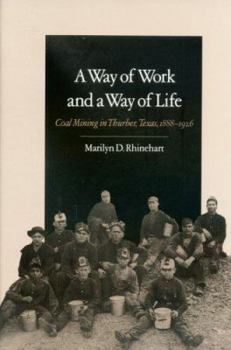A Way of Work and a Way of Life: Coal Mining in Thurber, Texas, 1888-1926 (Texas a and M Southwestern Studies)
(Part of the Texas A&M Southwestern Studies Series)
Select Format
Select Condition 
Book Overview
The coal mine represented much more than a way of making a living to the miners of Thurber, Texas, in the late nineteenth and early twentieth centuries--it represented a way of life. Coal mining dominated Thurber's work life, and miners dominated its social life. The large immigrant population that filled the mines in Thurber represented more than a dozen nations, which lent a certain uniqueness to this Texas town. In 1888 Robert D. Hunter and the Texas & Pacific Coal Company founded the town of Thurber on the site of Johnson Mines, a small coal-mining village on the western edge of North Central Texas where Palo Pinto, Erath, and Eastland counties converged. William Whipple and Harvey E. Johnson first established a small community there in 1886 as the railroads' demand for coal enhanced the possibility of financial reward for entrepreneurs willing to risk the effort to tap the thin bituminous coal veins that lay beneath the ground. Where the first comers failed, Hunter and his stockholders prevailed. For almost forty years the company mined coal and owned and operated a town that by 1910 served as home to more than three thousand residents. In some respects, the town mirrored the work and culture of bituminous coal-mining communities throughout the United States. Like most, it experienced labor upheaval that reached a dramatic climax in 1903 when the United Mine Workers, emboldened and strengthened by successes in other parts of the Southwest, organized Thurber's miners. Unlike others, however, the miners' success at Thurber was not fraught with violence and loss of life; furthermore, in the strike's aftermath good relations generally characterized employer/employee negotiations. Marilyn Rhinehart examines the culture of the miners' work, the demographics and social life of the community, and the benefits and constraints of life in a company town. Above all she demonstrates the features both at work and after work of a culture shaped by the occupation of coal mining.
Format:Paperback
Language:English
ISBN:1585445398
ISBN13:9781585445394
Release Date:January 2006
Publisher:Texas A&M University Press
Length:192 Pages
Weight:0.62 lbs.
Dimensions:0.4" x 6.0" x 9.0"
Customer Reviews
1 rating
Worthwhile
Published by Thriftbooks.com User , 24 years ago
Although A Way of Work... concentrates on the "labor history" of Thurber, Chapter 2 (ca 20 pages equivalent to ca 20% of the actual text) superficially describes underground working conditions and methods of the coal cutters. Unfortunately, none of the other mine workers, nor their work, is more than mentioned in passing. Very little description is given of the mines themselves nor their operation-for example it is unclear even how many shafts were in operation at any particular time. In addition to labor history and the lives of the coal cutters, most of the remaining space is given to a description of the sociology of the company town. The book has other annoying empty holes, such not even superficially mentioning the fate of the town after 1926. But overall, A Way of Work...is well written and worthwhile.






